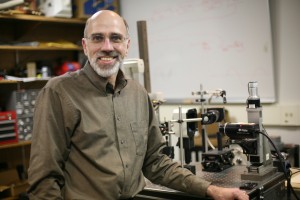
Tom Huber in his research laboratory.
Gustavus Adolphus College recently received a $310,000 grant from the National Science Foundation (NSF) to purchase a Polytec Scanning Laser Doppler Vibrometer to support the research program of Professor of Physics Tom Huber.
The award is funded by the Major Research Instrumentation Program Recovery and Reinvestment (MRI-R2), which is an initiative of the American Recovery and Reinvestment Act of 2009. This program is one facet of the NSF’s commitment to strengthen the research infrastructure at the nation’s science and engineering research and education institutions.
The new vibrometer will serve as the centerpiece of a new cyber-enabled acoustics laboratory that will not only benefit Gustavus students and faculty, but collaborators across the country. In April, Huber received a three-year $220,000 NSF grant to study the use of ultrasound to excite vibrations in microcantilevers that are less than a third the width of a single strand of hair. The new vibrometer enable much greater sensitivity for detecting vibrations of these microcantilevers that are used as physical, chemical, or biological sensors.
“The acquisition of this instrument will allow Gustavus students access to a state-of-the-art piece of equipment to perform vibration and acoustics work,” Huber said. “It will also allow them to collaborate, through the cyber-enabled lab, with well-known researchers from institutions such as Purdue and Stanford, who do not have access to a scanning vibrometer.”
The new vibrometer and acoustics laboratory will allow Gustavus students and faculty to research and study a broad span of acoustic and vibration topics, with another major goal being the study of the physics of musical instruments.
“There are many open questions in musical acoustics, and this project will enable us to better understand how musical instruments work,” Huber said. “The vibrometer will not only allow us to measure vibration of microscopic cantilevers, but also instruments as large as a piano, guitar or an organ pipe.”
The NSF is an independent federal agency created by Congress in 1950 “to promote the progress of science; to advance the national health, prosperity, and welfare; and to secure the national defense.” With an annual budget of about $6.06 billion, it is the funding source for approximately 20 percent of all federally supported basic research conducted by America’s colleges and universities.